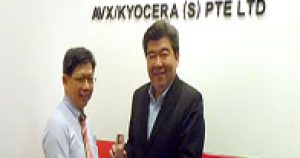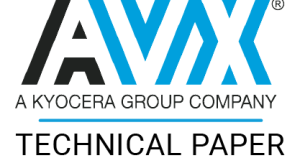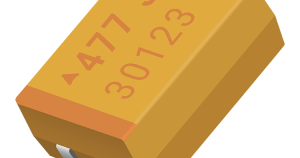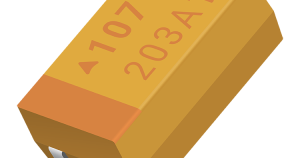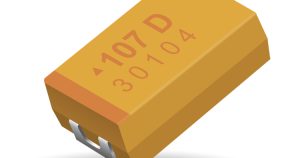FOUNTAIN INN, S.C. (April 28, 2015) – AVX Corporation, a leading manufacturer of passive components and interconnect solutions, is attending the 2015 Electronic Distribution Show (EDS), which will take place May 12 – 15 at The Mirage Hotel and Casino in Las Vegas. At the event, AVX will introduce four new products, meet with its various sales and distribution partners, and attend the 2015 ECN Impact Awards as a finalist in the Passive Components and Discrete Semiconductors category. The premier annual event for the international electronic distribution industry, EDS hosts approximately 5,000 individuals representing more than 80% of the industry each year. Participants include electronic distributors, suppliers who provide distributors with an array of value-added equipment and services in addition
Learn More →News / Events / Press
FOUNTAIN INN, S.C. (April 24, 2015) – AVX Corporation, a leading manufacturer of passive components and interconnect solutions, has received a prestigious 2014 TTI Asia Supplier Excellence Award. Bestowed by TTI, Inc., the leading authorized distributor of interconnect, passive, electromechanical, and discrete components, the award honors AVX for its successful fulfillment of several key quality performance metrics designed to elevate supplier and distributor performance in order to ensure utmost customer satisfaction. The 2014 TTI Asia Supplier Excellence Award represents the highest recognition possible of a supplier’s performance within TTI Asia with regard to quality acceptance, ship-to-commit delivery date, effective business systems, ease of doing business, and the quality and efficacy of field employee and management relationships. Mr. Anthony Chan, President,
Learn More →FOUNTAIN INN, S.C. (MARCH 17, 2015) – AVX Corporation, a leading manufacturer of passive components and interconnect solutions, has introduced a single contact version of its proven 9176 Series insulation displacement connectors (IDCs), which are widely recognized for providing highly reliable, gas-tight wire-to-board connections in a range of harsh environment applications. Backward compatible with existing 9176 Series connectors with regard to contact and footprint, the new 9176-65X single tine IDC contacts exhibit the same robust, reliable performance the series is known for while reducing cost by 25%, width by 50% (2.5mm vs. 5.0mm), and height by 10% (5.05mm vs. 5.6mm), the latter of which is especially valuable for SSL applications, as it helps prevent shadowing. Designed to satisfy the demanding
Learn More →Polymer Tantalum Capacitors with Suppressed Transient Current Written By: Jan Petržílek | Miloslav Uher | Jiří Navrátil Abstract: Tantalum electrolytic capacitors are renowned for their high capacitance and volumetric efficiency, parametric stability over a long service lifetime, and long-term reliability under harsh operating conditions. The anode is constructed of a porous pellet of sintered tantalum powder with a dielectric of tantalum pentoxide formed by electrochemical anodization. The traditional cathode materials have been either a liquid electrolyte (wet hermetic types) or manganese dioxide (solid MnO2 surface mount types). However, the most recent material, fast becoming a popular option, is conductive polymer. The Polymer Tantalum capacitor was originally marketed toward consumer electronic applications, however after years of effort and continuous improvement, significant
Learn More →Voltage Derating Rules for Solid Tantalum and Niobium Capacitors Written By: Tomáš Zedníček | John Gill Abstract: For many years, whenever people have asked tantalum capacitor manufacturers for general recommendations on using their product, the consensus was “a minimum of 50% voltage derating should be applied”. This rule of thumb has since become the most prevalent design guideline for tantalum technology. This paper revisits this statement and explains, given an understanding of the application, why this is not necessarily the case. With the recent introduction of niobium and niobium oxide capacitor technologies, the derating discussion has been extended to these capacitor families also.
Learn More →Ultrathin Discrete Capacitors for Emerging Embedded Technology Written By: Radim Uher | Tomas Zednicek Abstract: Passive components can represent as much as 70% of PCB footprint in today’s electronic systems. The development of a suitable technology whereby integrated passive components are embedded into the PCB body has been one of the key trends in downsizing for more than a decade. Latest achievements have allowed the implementation of this ‘embedding technology’ into pre-production and even mass production. The next step requires the involvement of the complete supply chain, including traditional passive component manufacturers. This paper will present the state of the art in the development of ultrathin discrete capacitor technology and discuss the challenges of overcoming mechanical, electrical and thermo-mechanical issues
Learn More →Thermal Management of Surface Mounted Tantalum Capacitors Written By: Ian Salisbury Abstract: This paper covers thermal management of surface mounted tantalum capacitors, and explores the thermal characteristics and how these are modified by the thermal interconnection substrate. The paper explores the different methods of mounting to reduce the thermal resistance to the PCB, also the affect of the design of connection pads on the PCB to reduce the thermal stress on the capacitor.
Learn More →Thermal and Electrical Breakdown Versus Reliability of Ta2O5 under Both – Bipolar Biasing Conditions
Thermal and Electrical Breakdown Versus Reliability of Ta2O5 under Both – Bipolar Biasing Conditions Written By: P. Vašina | T. Zedníček | Z. Sita | J. Sikula | J. Pavelka Abstract: Our investigation of breakdown is mainly oriented to find a basic parameters describing the phenomena as well as its impact on reliability and quality of the final product that is “GOOD” tantalum capacitor. Basically, breakdown can be produced by a number of successive processes: thermal breakdown because of increasing conductance by Joule heating, avalanche and field emission break, an electromechanical collapse due to the attractive forces between electrodes electrochemical deterioration, dendrite formation and so on. Breakdown causes destruction in the insulator and across the electrodes mainly by melting and
Learn More →Tantalum Capacitors Technology for Extended Operating Temperature Range Written By: T.Zedníček | Z.Sita | S.Pala Abstract: New materials, capable to operate at higher temperatures, new techniques of their processing and new procedures for increasing the stability have been implemented to AVX THJ series to extend the continuous operating temperature up to 175°C while maintaining twice better reliability specification compare to the standard range of tantalum capacitors.
Learn More →Tantalum and Oxicap® Niobium Oxide Capacitors Deliver Enhanced Reliability, Wide Temperature Range & Low Leakage for Automotive Applications Written By: R. Faltus Abstract: In nowadays modern cars we can find many electronic systems controling engine, gear box, caring for passenger comfort, assuring safety and security, etc. Automotive applications are specific by their harsh electrical and environmental conditions together with requirements for high overall reliability and lifetime. Any electronic part used in such system play important role to assure reliability and functionality. Different capacitor technologies –tantalum, MLCC, NbO, aluminium are available but some of them meet the specific requirements better than others.
Learn More →Tantalum and Niobium Technology Roadmap Written By: T. Zednicek | B. Vrana | W. A. Millman | J. Gill | Chris Reynolds Abstract: This paper presents an overview of the key features of emerging capacitor technologies – tantalum, niobium metal and niobium oxide in order to give designers a better understanding of the potential applications and to guide their choice of component solutions for their individual requirements. The second part of the paper is targeted to a new type of solid electrolyte capacitor that has been developed based on niobium oxide powder material. Capacitors made from niobium oxide powder offer the designer many interesting features such as significantly reduced ignition failure mode, better load resistance, reduced cost, etc. The paper
Learn More →TA Capacitors With Conductive Polymer Robust to Lead Free Process Written By: Z. Sita | M. Biler Abstract: Tantalum capacitors with conductive polymer cathodes have found a place in the market as a low ESR component with reduced ignition. Conductive polymer cathodes however, suffer from instability during multiple high temperature thermal treatments such as lead free soldering due to its limited self healing ability and lower thermal and mechanical strength compared with manganese dioxide. This makes capacitors with conductive polymer cathode more sensitive to thermo-mechanical stresses, which appear during soldering and to negative influences of storage condition after removal from the protective packaging prior to soldering. This paper describes methods of improving the robustness of such capacitors with lead free
Learn More →Storage Capacitor Properties and Their Effect on Energy Harvester Performance Written By: Radovan Faltus | Miroslav Jáně | Tomáš Zedníček Abstract: The development of energy harvesters has quickened up in the last few years mainly due to semiconductor improvements. But power sources for energy harvesters usually exhibit high internal impedance and can therefore only deliver low currents. The most important consideration for harvesting is that the power consumption of the controller circuitry must be less than the energy generated by the power source. Energy harvesters use a storage capacitor slowly charged from power source through the controller and the leakage current of this capacitor is wastes a certain percentage of the generated energy. This paper will evaluate this effects of
Learn More →SMD Tantalum Capacitors Break Limit of 200degC for Continuous Operation Written By: R. Faltus | T. Zedníček Abstract: Capacitors are one of the key parts of any electronic device and system. The main functions of capacitors include power supply voltage smoothing, supporting energy sources when high current pulse is demanded, blocking a DC voltage in signal pathes, filtering, etc. To assure required functionality of a system we cannot omit capacitors and it is valid for high temperature applications as well. In oil and gas mining industry a high temperature capacitors are needed for DC/DC converter of drilling heads that are subjected to rising ambient temperature with depth. Thus the higher permitted operating temperature of used capacitor and other passive and
Learn More →Smallest and Lowest Profile Tantalum Capacitors Written By: T. Zednicek | I. Paukert | I. Zednickova Abstract: Tantalum capacitor technology has been recognized for its parametric stability and long term reliability in the most demanding of applications. Unlike some other capacitor technologies, tantalum capacitors do not exhibit significant capacitance change over time and voltage. The other benefit is that due to its mechanical strength it is possible to manufacture flat & thin designs, so why these type of capacitors are the best fit for tasks such as “can you make higher capacitance in the lowest profile? “ The paper provides an overview of such tantalum capacitors suitable for most demanding sub millimeter size and low profile capacitors down to 0201
Learn More →Selecting Back-Up Capacitors for Modern Solid State Drives Written By: Radovan Faltus Abstract: High speed cache memory greatly improves SSD performance. Providing a power backup for DRAM buffer memory assures no data loss on power switch off or failure, and also improves speed and reaction time after power on.
Learn More →